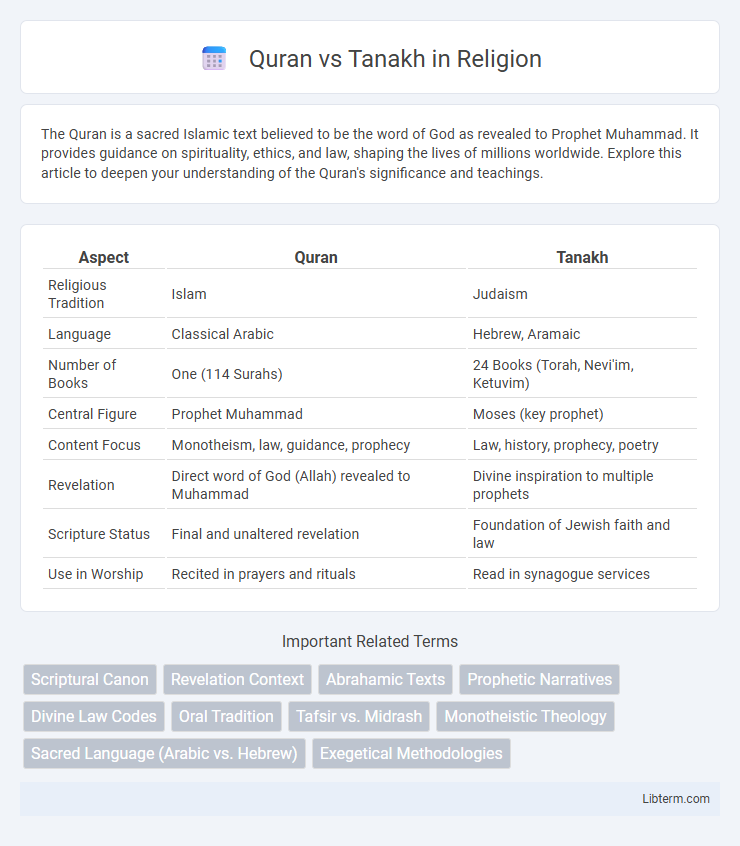The Quran is a sacred Islamic text believed to be the word of God as revealed to Prophet Muhammad. It provides guidance on spirituality, ethics, and law, shaping the lives of millions worldwide. Explore this article to deepen your understanding of the Quran's significance and teachings.
Table of Comparison
| Aspect | Quran | Tanakh |
|---|---|---|
| Religious Tradition | Islam | Judaism |
| Language | Classical Arabic | Hebrew, Aramaic |
| Number of Books | One (114 Surahs) | 24 Books (Torah, Nevi'im, Ketuvim) |
| Central Figure | Prophet Muhammad | Moses (key prophet) |
| Content Focus | Monotheism, law, guidance, prophecy | Law, history, prophecy, poetry |
| Revelation | Direct word of God (Allah) revealed to Muhammad | Divine inspiration to multiple prophets |
| Scripture Status | Final and unaltered revelation | Foundation of Jewish faith and law |
| Use in Worship | Recited in prayers and rituals | Read in synagogue services |
Introduction to the Quran and the Tanakh
The Quran, composed in classical Arabic, serves as the central religious text of Islam, believed to be a revelation from God to Prophet Muhammad over 23 years. The Tanakh, also known as the Hebrew Bible, comprises three parts: the Torah (Law), Nevi'im (Prophets), and Ketuvim (Writings), forming the canonical collection of Jewish scriptures. Both texts hold foundational significance for their respective religions, guiding spiritual beliefs, ethical principles, and cultural traditions.
Historical Context and Origins
The Quran, revealed in the 7th century CE in the Arabian Peninsula, reflects the religious and cultural milieu of early Islam, emphasizing monotheism and prophetic tradition. The Tanakh, composed over centuries in ancient Israel and Judah, encompasses diverse genres including law, prophecy, and history, reflecting the evolving religious and social identity of the Hebrew people. Both texts serve as foundational scriptures in their respective faiths, shaped by distinct historical contexts that influenced their theological themes and narrative structures.
Structure and Composition
The Quran is composed of 114 surahs arranged primarily by length rather than chronological order, featuring a poetic and rhythmic style that facilitates memorization and recitation. The Tanakh, structured into three main sections--Torah (Law), Nevi'im (Prophets), and Ketuvim (Writings)--employs a diverse literary composition including narrative, law codes, poetry, and prophecy. Both texts exhibit unique organizational frameworks reflecting their distinct theological and historical contexts, with the Quran emphasizing divine revelation in a unified scripture and the Tanakh presenting a compilation of varied genres over centuries.
Language and Literary Style
The Quran is primarily written in classical Arabic, characterized by its rhythmic and eloquent prose that combines poetic elements with a unique narrative flow, enhancing memorability and oral recitation. The Tanakh, composed mainly in Biblical Hebrew with some portions in Aramaic, exhibits diverse literary styles including poetry, prophecy, and historical narrative, reflecting its compilation over centuries by multiple authors. Both texts utilize distinct linguistic features and rhetorical devices that serve religious, cultural, and didactic purposes within their respective traditions.
Major Themes and Messages
The Quran emphasizes submission to the one God (Allah), guidance through prophets, and the importance of faith, compassion, and justice as central themes. The Tanakh, comprising the Torah, Prophets, and Writings, focuses on covenantal relationships between God and the Israelites, moral laws, and historical narratives that shape Jewish identity and ethics. Both texts highlight divine revelation, ethical conduct, and the consequences of human choices, yet the Quran's message centers on monotheism and universal guidance, while the Tanakh emphasizes particularism and the unfolding of God's covenant with Israel.
Prophets and Key Figures
The Quran features prophets such as Muhammad, Moses, Jesus, and Abraham, emphasizing their roles as messengers conveying God's guidance to humanity. The Tanakh highlights key figures including Moses, David, Solomon, and Elijah, focusing on their leadership, covenantal relationship with God, and the foundation of Jewish law and tradition. Both texts share figures like Moses and Abraham but present distinct theological narratives and prophetic missions reflective of Islamic and Judaic faiths.
Laws, Ethics, and Guidance
The Quran provides comprehensive laws and ethical guidelines governing personal conduct, social justice, and worship with emphasis on mercy and accountability, while the Tanakh encompasses Mosaic laws detailed in the Torah focused on covenantal duties and community ethics. Both scriptures serve as foundational moral guides, but the Quran integrates legal rulings with spiritual principles in a unified text, whereas Tanakh's laws are part of a broader historical and prophetic narrative. Their respective teachings shape distinct religious legal systems: Sharia in Islam and Halakha in Judaism.
Textual Transmission and Preservation
The Quran's textual transmission is characterized by a meticulous oral and written preservation process, with Hafs-style recitations and the Uthmanic codex serving as primary authoritative sources since the 7th century. In contrast, the Tanakh exhibits a more complex transmission history involving multiple manuscript traditions such as the Masoretic Text, Dead Sea Scrolls, and Septuagint, reflecting variations and editorial developments over centuries. Both texts demonstrate significant scholarly efforts to preserve authenticity, yet the Quran's standardized codification shortly after its revelation contrasts with the Tanakh's broader textual diversity and extended compilation timeline.
Role in Religious Practices
The Quran serves as the primary scriptural foundation in Islam, guiding daily prayers, fasting, and rituals such as Hajj, while the Tanakh functions as the sacred text in Judaism, informing worship, mitzvot (commandments), and festivals like Passover and Yom Kippur. Quranic recitation and memorization play central roles in Islamic devotional life, whereas the Tanakh is studied extensively in synagogue services and Torah readings. Both scriptures shape ethical frameworks, communal identity, and religious law within their respective faith traditions.
Influence on Global Civilizations
The Quran has profoundly shaped Islamic civilization, influencing legal systems, art, literature, and philosophy across the Middle East, North Africa, and parts of Asia for over 1,400 years. The Tanakh, foundational to Judaism, has significantly impacted Western culture, ethics, law, and literature, informing Christian and Islamic traditions. Both texts continue to guide billions, shaping moral frameworks and cultural identities worldwide.
Quran Infographic

 libterm.com
libterm.com